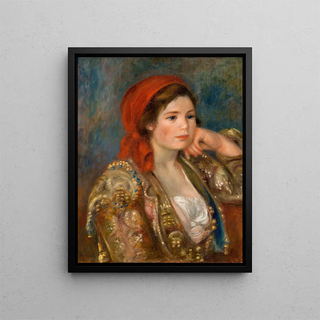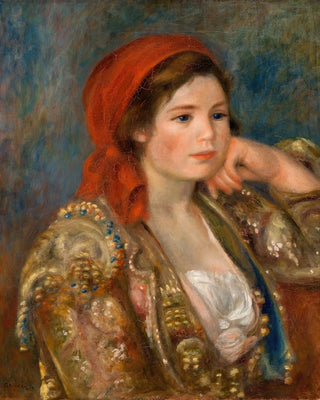Art print | Girl in Spanish jacket - Pierre-Auguste Renoir


View from behind

Frame (optional)
In the vibrant world of Impressionism, the artwork "Fille en veste espagnole" by Pierre-Auguste Renoir stands out for its delicacy and brilliance. Created in 1879, this painting reflects the artist's sensitivity, capturing the ephemeral beauty of a young girl through a palette of luminous colors. The scene depicts a female figure dressed in a Spanish jacket, a symbol of fashion and culture, evoking both grace and joie de vivre. The piece invites viewers to immerse themselves in a universe where movement and light combine to create an intimate and warm atmosphere.
Style and uniqueness of the artwork
Renoir, an undisputed master of Impressionism, manages to transcend simple representation through a unique approach to light and color. In "Fille en veste espagnole," he employs fluid, light brushstrokes that breathe life into the canvas. The texture of the paint, soft yet vibrant, gives the young girl an almost tangible presence. The shades of red and blue in her jacket contrast delicately with the background, enhancing her radiance and beauty. This work is also characterized by its sense of movement, where the posture of the young girl seems to capture a fleeting moment, as if she might come to life at any instant. Renoir thus succeeds in creating a dialogue between the subject and the environment, highlighting the harmony between human beauty and nature.
The artist and his influence
Pierre-Auguste Renoir, an iconic figure of the Impressionist movement, left a mark on his era with an innovative artistic vision. Born in 1841, he evolved in an environment where painting was freeing itself from academic constraints. His focus on light and color influenced many artists, both contemporaries and future generations. Renoir always sought to depict life as it is, with its joys and sorrows, its movements and silences. Through his works, he celebrated everyday beauty, transforming ordinary scenes into moments of grace. His ability to capture human emotion and beauty

Matte finish

View from behind

Frame (optional)
In the vibrant world of Impressionism, the artwork "Fille en veste espagnole" by Pierre-Auguste Renoir stands out for its delicacy and brilliance. Created in 1879, this painting reflects the artist's sensitivity, capturing the ephemeral beauty of a young girl through a palette of luminous colors. The scene depicts a female figure dressed in a Spanish jacket, a symbol of fashion and culture, evoking both grace and joie de vivre. The piece invites viewers to immerse themselves in a universe where movement and light combine to create an intimate and warm atmosphere.
Style and uniqueness of the artwork
Renoir, an undisputed master of Impressionism, manages to transcend simple representation through a unique approach to light and color. In "Fille en veste espagnole," he employs fluid, light brushstrokes that breathe life into the canvas. The texture of the paint, soft yet vibrant, gives the young girl an almost tangible presence. The shades of red and blue in her jacket contrast delicately with the background, enhancing her radiance and beauty. This work is also characterized by its sense of movement, where the posture of the young girl seems to capture a fleeting moment, as if she might come to life at any instant. Renoir thus succeeds in creating a dialogue between the subject and the environment, highlighting the harmony between human beauty and nature.
The artist and his influence
Pierre-Auguste Renoir, an iconic figure of the Impressionist movement, left a mark on his era with an innovative artistic vision. Born in 1841, he evolved in an environment where painting was freeing itself from academic constraints. His focus on light and color influenced many artists, both contemporaries and future generations. Renoir always sought to depict life as it is, with its joys and sorrows, its movements and silences. Through his works, he celebrated everyday beauty, transforming ordinary scenes into moments of grace. His ability to capture human emotion and beauty






